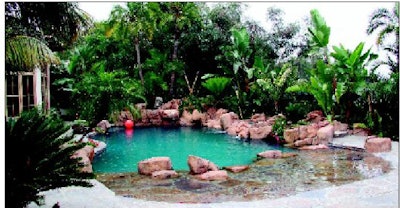
Randy Beard, owner of Pure Water Pools in Costa Mesa, Calif., says most of his clients who know about beach entries want one. And who can blame them. They're beautiful, kids love playing in them and adults enjoy lounging in them. But the gentle, gradual slope that makes them so appealing also takes up a lot of space. Unfortunately, not every backyard can accommodate a beach entry.
"During the design consultation phase, beach entries come up a lot," says Beard, a platinum member of the Genesis 3 Design Group. "And this is when you determine whether it's possible to do one. Quite often, I'm in a situation where they say, 'We would like a beach entry,' and I have to explain how much space a beach entry takes up in a swimming pool. And that's the deciding factor.
"Most people decide they don't have enough room to have a full beach entry. Imagine if we're working at a 3 percent or 4 percent grade, it would take them almost 28 lineal feet to have a full beach entry. Since the majority of Americans don't have the space to build a 60- or 70-foot-long pool with a third of it in beach entry, they do various different things to get beach entries in," says Beard. One option is to build an abbreviated beach entry that slopes to a sun shelf. "This allows them to go from zero to a certain amount of entry less than 28 feet. Then they can take that shelf down to a typical 3-foot depth at the end of the shelf. The danger there is you now have a right angle under the water where it's not visible, and there's a risk of somebody diving into the pool and hitting that right angle, so we need to disclose that and make the client very aware of what it is we're doing."
Many clients who initially want a beach entry eventually decide against it and end up with a sun shelf (also called a Baja shelf or a Cabo shelf), says Beard, because they do not have adequate space for a full beach entry. A sun shelf has some of the features of a beach entry — a shallow area to sit, either in the water or in a lounge chair — but doesn't require the space to complete the slope.
"There's a step down [to the sun shelf] to a certain depth of water, which is often anywhere from 9 to 15 inches," says Beard. Then there's another drop to the depth of the main vessel.
Whether clients go with a beach entry, an abbreviated beach entry or a Baja shelf, Beard says many are also requesting that they be built to accommodate a large umbrella. "They're great places to put a beach chair and sit under an umbrella and read a book while the kids play."
STRUCTURAL SUPPORT
Though a beach entry itself is rather shallow, the support system underneath it needs to be deep — it should not sit on top soil. "Under the beach entry, there's an inverted bond beam," says Beard. "The beam gets turned upside down and there's a deepened footing, so while the water on top is shallow, the gunite is actually much deeper there and in most cases, you have a total of 18 to 24 inches of concrete under that beach entry and the beam of the pool extends on out past where the water stops, sometimes as much as 2 or 3 feet, depending on what percentage rate you're going into the water with."
Also, keep in mind that both the beach entry and deep end need to be in the same type of soil. A soils engineer can be especially helpful here. "You have to be on what is known as like soil, which is a little bit deeper," says Beard. "When we get 3 feet down, we've cleaned off all of that topsoil that really has no structural value. So while you're digging, you need to make sure that the soil you're embedded in for the beach entry is the same soil you're embedded in for the deep end. Building in differential soil is a no-no in the pool business. That's what causes cracks."
CHOOSING MATERIAL
Ideally, a beach entry is not only attractive, but also neither too smooth (to guard against slipping) nor too gritty. So what's the best material to use? "We always recommend that people use the product that they have on the deck to move right into the beach entry because that's what creates the illusion that the deck goes into the water," says Beard. "At the beach, you don't separate one from the other, except one is wet and one is dry — it's sand all the way down in. I think the best-looking jobs we do use the same decking product right on into the water."
The decking product Beard prefers is natural stone. "You have to make sure your stones are welcome in a pool environment. We've used limestone, as well as other things. Every job is different, but it just makes sense not to have a break there because it makes the beach entry less believable."
SAFETY
For beach entries with a drop off and for sun shelves, it's important to indicate the depth change to swimmers.
"Sometimes, we put rocks at the right angle to alert the swimmers that they're coming up to that shelf," says Beard. "We've also used .oating rope rings and we've seen trim tile used. We've used fiber optics to light the edge. In that 1-foot shelf, for nighttime swimming, often we'll put the light in there to alert swimmers."
To learn more from Randy Beard, attend his presentation at the AQUA Show. Go to aquashow.com for more information.








































